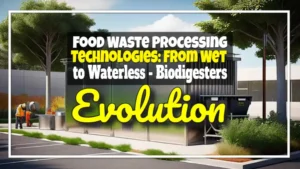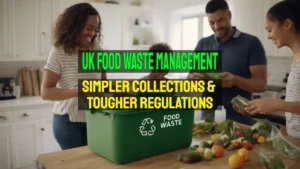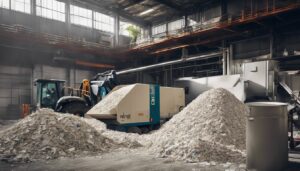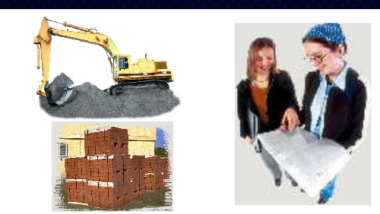 It's no longer good enough to assume that waste is everything we don't want any more. Applying Integrated Sustainable Waste Management and good Construction Site Waste Management asks questions. Can we reduce the waste, reuse it, recycle it, and if not can we extract heat energy from it?
It's no longer good enough to assume that waste is everything we don't want any more. Applying Integrated Sustainable Waste Management and good Construction Site Waste Management asks questions. Can we reduce the waste, reuse it, recycle it, and if not can we extract heat energy from it?
By doing this it has been found that the amount of waste construction site workers create on site can be considerably reduced.
Save Money Through Adopting Sustainable Waste Management
What is even better though is that contractors are saving money by spending time to see if re-use, and recycling is possible on a site by site basis.
By careful segregation to avoid the presence of “other” and unwanted “contaminating” materials” within a waste type, the value of some of the materials from demolition can be greatly enhanced.
These high purity recyclates can then become re-classified as raw materials themselves, not waste. In this way by adopting the ideas of Integrated Sustainable Waste Management (ISWM), the quantity of waste to deal with can itself be reduced.
It is done by meticulous storage, moving and handling of materials.
The Site Waste Management Plan
Creating and applying a Construction Site Waste Management Plan (SWMP) is now seen as good practice for all larger United Kingdom construction site projects above a certain size, and this it is aimed at halving the amount of construction waste which will be sent to landfill in future.
Handling waste poorly will waste time, money, and effort. It also, of inevitably reduces profitability because the cost of UK landfill disposal is now so high.
Construction Site Waste Management Plans in Easy Steps Video
View Site Waste Management Plans (SWMPs) in 9 Easy Steps on YouTube Here
(UPDATE TO VIDEO: As part of the UK Government's drive to reduce red tape burdens, the Site Waste Management Plans Regulations 2008 have been repealed. As of 1 December 2013, there is no legal duty to produce a site waste management plan for any construction project. (See SI 2013/2854))
The Cost of Not Planning Ahead for Construction Waste
It takes time along with cash to re-handle trash that was not managed properly at first. It costs money to lay up the rubbish on site, to move it from site, and to dispose of it. Landfilling waste is expensive. Waste disposed to landfill is subject to landfill tax which is currently just over £90/tonne.
Turning Waste Liabilities Into Extra Income on a Construction Project
The liability which is waste, can be turned into extra income with careful waste management planning.
Construction companies, can for example dispose of their construction waste soil, and waste clay to a landfill operator to make use of as daily cover. There are two bands of landfill tax in the UK, active and inert – active waste is subject to a vastly more elevated rate than inert waste. From 1 April 2020 the Standard rate of Landfill Tax £ per tonne (England) will be £94.15, but the lower band rate for inert landfill site development materials will be just £3.00.
If these are mixed, the one the upper price of tax will be charged on the full load, so segregating rubbish saves money. But, best of all is to sell these materials as landscaping soil, and to crush demolished concrete to sell as aggregate. In this way, as the cost of raw materials rises, a net cost, can become a net income.
What is Integrated Sustainable Waste Management?
The principal concept of Integrated Sustainable Waste Management (ISWM) has been developed out of familiarity, to take in hand certain common problems with municipal waste management in low-and middle-income countries in the South, and also in countries in transition. ISWM recognizes three principal features in waste management:
(1) stakeholders,
(2) waste scheme elements and
(3) sustainability aspects.
Waste Management Hierarchy
The waste management hierarchy, which is a policy guideline that is part of many country's environmental laws and policies is also a basis of the ISWM approach.
The crucial objectives of the strategy/ trash hierarchy are to reduce the amount of waste produced, to intensify the quantity of waste recycled and to limit the menace of contamination from other waste materials.
The term waste has a distinct consequence from one person to the next. As a rule it can be said would say that waste is not needed for the person who throws it out. So, waste is a product or substance that does not comprise a value to any further extent for the leading consumer and is as a result thrown away.
However, the perception of “redundant” can be purely subjective. One person's waste may perhaps hold worth for another person in a different situation, or similarly in another society. In the last decade re-use and recycling has developed so that there are now numerous large industries that operate first and foremost, or even exclusively, by means of using trash materials (such as paper and metals, which are the commonest) as their industrial feed stocks.
Sustainability – Reducing Pressure on the Environment
The money-making potential of entire nations, can be enhanced by reducing pressures on its environment, and improving recycling can offset other environmentally detrimental actions. Particular of these negative actions have to do with the creation and disposal of trash.
Founded upon the UK policy document ‘Making Waste Work' published during 1995, the Waste Strategy 2000 for England and Wales described the future policies regarding the recovery and disposal of waste, and most have now been implemented. Similar policies have been in-place for some time throughout Europe, and are a legal requirement for all EU nations.
On the way to accomplish much better waste management, the concept of sustainable development has been introduced. Sustainable development is concerned with achieving profitable growth, in the form of elevated living standards while protecting the environment. It is absolutely not about hair shirts and scrimping and economy, or punishing ourselves for enjoying the use of the planet's capital right-now.
Concluding – Why Construction Site Waste Management Needs to Become Integrated Sustainable Waste Management
One of the most critical areas for society to act sustainably is in how it throws away its waste, its junk and debris. Nothing else, other than fossil fuel energy over-use causing climate change, and war, has the potential to do so much accumulating damage.
The Circular Economy In Fashion: Making Clothes Sustainable
Fast fashion fills our wardrobes, but most clothes end up in landfills within a year. Introducing the concept of the circular economy in fashion. It's the best hope for making our clothes sustainable. The global clothing industry creates over 92 million tonnes of waste each year, making it one of Earth's biggest polluters. A circular […]
The Evolution of Food Waste Processing Technologies: From Wet to Waterless Biodigesters
Read on for the latest news on the development of wet and waterless biodigesters as a means of processing Food Waste. As food waste management becomes an increasingly pressing issue for environmental sustainability, the evolution of waste processing technologies has been a game-changer in how we handle organic material. For decades, the food waste processing […]
The Future of UK Food Waste Management – Simpler Collections and Tougher Regulation
The future of UK food waste management will be a big push toward higher recycling rates through simpler collection and far greater consistency across the nations, helping citizens understand how to be green and recycle more organic waste. As the UK continues to advance its environmental goals, recently announced government policies aimed at simplifying waste […]
The Ultimate Guide To Recycling Plasterboard: How To Dispose Of Plasterboard Waste Properly
Plasterboard is a popular building material used in homes and offices. It's light, strong, and easy to work with. But when it turns into waste, we can't just throw it away like old food wrappers. Rules say plasterboard must not mix with other trash because it can harm the environment. Luckily, clean plasterboard can go […]










The reasons for construction waste management to be made more sustainable relate to the political and social structures which control and implement waste management: the distribution of functions and responsibilities; the organisational structures, procedures and methods implicated; the available institutional capacities; and the actors such as the private sector who could become involved. Planning is often considered the principal activity in relation to institutional and organisational aspects.